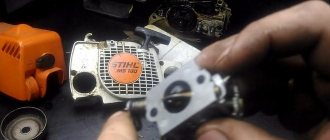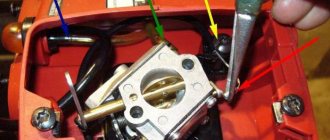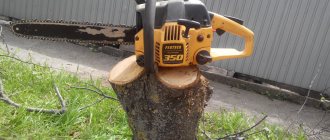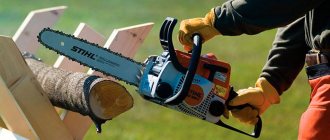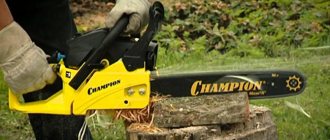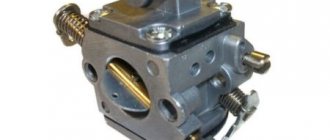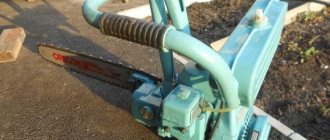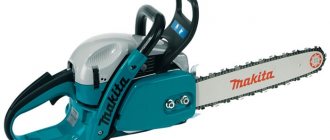Carburetor Sthil MS180 (Shtil 180). Adjustment - no, I haven’t heard...
The Shtil MS 180 chainsaws produced now and in the last few years are equipped with Chinese-made carburetors, which have only one adjustment screw.
Such membrane-type carburetors are practically impossible to disassemble, since it is completely sealed and filled. So to say: “Adjustment - no, I haven’t heard...” In this case, it is easier to buy a Shtil 180 chainsaw carburetor, and both original carburetors (also made in China, but at a plant owned by STIHL) and from third-party (also Chinese) manufacturers are available for sale. It should be noted that despite being made in China, the original Shtil 180 carburetors are very reliable and rarely let their owners down. The price of an original carburetor for a Stihl 180 and a non-original one differs quite significantly. For example, if a non-original carburetor on the Internet costs from 700 rubles, then the original one costs 2500 rubles, that is, almost 4 times more expensive.
For chainsaws manufactured for 5 years or more, it is possible to purchase repair kits. The price of a repair kit for the Shtil 180 carburetor ranges from 200 to 400 rubles.
How to set up the carburetor of a Shtil 180 chainsaw?
We only have access to idle speed adjustment. Why is this necessary and how do you understand when you need to adjust the idle speed of a Shtil 180 chainsaw? This is necessary if the chain does not stop at idle, which can lead to injuries and unstable operation of the saw as a whole.
Procedure for adjusting the stihl MS 180 carburetor:
The Instructions for MS 180 describe how to set the idle speed on a chainsaw as standard:
Turn the idle speed adjustment screw counterclockwise until it goes tight, then turn it back two turns clockwise. Voila! Set up.....
If the idle speed on your saw is too low, then we perform the following actions:
- Rotate the adjustment screw clockwise until the chain begins to move along the bar.
- Rotate the screw half a turn counterclockwise.
If your speed is high and the chain does not stop turning:
- Turn the idle speed adjustment screw counterclockwise until the chain stops moving.
- Rotate the screw another half turn counterclockwise.
If you are unable to independently adjust the idle speed, you must contact a specialized service center.
Video about adjusting the Shtil chainsaw:
Here you can read about adjusting the Husqvarna carburetor:
How to make a tachometer with your own hands?
If it is impossible or expensive to restore a factory device, you can do it yourself. The same problem is often solved by owners of auto-moto vehicles that do not have a tachometer in their design.
Video of a simple tachometer assembled with your own hands from a voltmeter, a motor from an old printer and a diode bridge.
Installing the sensor on the crankshaft is quite difficult, and the balancing may be disrupted. It’s easier to use any pulley that rotates synchronously with the motor.
If there is a hole, install a photo pair and connect it to the electronic tachometer. The circuit can be purchased as a ready-made KIT kit (on Chinese electronics websites), or assembled using an available element base.
There are ways to connect a homemade tachometer to the ignition system. Each pulse applied to the high-voltage spark plug coil corresponds to one revolution of the crankshaft.
We remove the signal and feed it to the tachometer circuit. If the standard device on your car has failed, or you want to duplicate it on a separate display, it is possible to connect the tachometer to the generator. This is the most common pulse delivery scheme. We take the signal for the revolution counter from the “W” connector of the generator. The connection is standard, this is how many models of factory tachometers work.
If you have doubts about the correctness, look at the electrical diagram of your car, you need to find the conductor from the generator to the device.
Bottom line Making a homemade tachometer is quite simple if you have basic electrical engineering skills. If you have a soldering iron and a ready-made circuit, it’s a matter of a couple of days off.
An element base for every taste: from a simple pulse counter to a controller assembled on ARDUINO. The main thing is to understand how the standard device in your car works.
An example of a homemade tachometer from a computer mouse. All the details are in the video material.
What is it for? If the standard tachometer is broken, the answer is obvious. If everything is in order with your dashboard, you can add a stylish element to the interior of the car. The digital display is easier to read, and the LED indication will add clarity.
Adjusting the chainsaw carburetor
Content:
Chainsaws are a very popular gardening tool. They have gained great popularity among gardeners and those who care for the territory in their home areas. Construction or repairs cannot be done without chainsaws. Chainsaws are even more important in the lumberjack profession.
Any chainsaw requires proper care, maintenance and adjustment before use. If you put too much stress on the tool, it may shorten its life and cause the tool to break.
Today we will talk about that part of the chainsaw mechanism, the task of which is to prepare the fuel before it is supplied to the engine cylinder. This function is performed by the chainsaw carburetor. How well the chainsaw works and how much fuel it consumes during operation will depend on it. If you see that your gasoline chain saw is starting to run erratically, the carburetor may need to be adjusted.
In what cases is it necessary to adjust the carburetor of a chainsaw?
Here is a list of the most common cases in which it is necessary to adjust the carburetor of a chainsaw:
- The engine starts, but the chainsaw stalls, or it cannot be started at all. The cause may be too much air in the fuel chamber.
- Increased fuel consumption. It can occur due to excessive saturation of the mixture that enters the engine with fuel. For the engine to work well, the mixture must be of high quality.
- The bolts in the carburetor have become loose due to a damaged carburetor body.
- Debris getting into the carburetor. This can happen if the filter is damaged or low-quality fuel is used. You will need to completely disassemble the carburetor, clean it and re-tune it.
- The engine idles poorly or does not develop full power.
Important! If the engine runs poorly because the piston is worn out, adjusting the carburetor will not work. In addition, along with the adjustment, it is advisable to clean the carburetor of debris - this will increase the effectiveness of the procedure.
Carburetor design
A carburetor is a mechanism that is responsible for preparing a mixture of fuel and air, which is then supplied to the engine cylinder. Most chainsaws have very similar carburetors, so they are set up in the same way.
The main structural parts of a carburetor on a chainsaw:
- Aluminium case. Aluminum is chosen as a material due to its low weight. Chainsaws are tools that constantly need to be held and carried, so reducing the weight of the tool is a very important task facing the manufacturer.
- Diffuser and air damper, which are located at the inlet of the carburetor.
- Jets are valves that provide dosage of fuel that is supplied to the carburetor.
- The atomizer, which is responsible for injecting fuel into the chamber.
- Fuel chamber.
Summing up
Having sufficient experience, the setup is completed in 5-10 minutes. Provided all carburetor parts are in good working order, the adjustment process should not cause any difficulties. If something is faulty in the carburetor, then you won’t be able to adjust it, no matter how hard you try. To do this, before making adjustments, you need to eliminate all faults.
I will write about what kind of malfunctions there are, how to find and fix them, in the next article about repairs, provided that this is of interest to you. Therefore, if the article helped, rate it and write in the comments below whether the second part of the article is needed. Thanks to all.
Source
Chainsaw High Speed Idling
We adjust the chainsaw carburetor without the help of others
A chainsaw is an indispensable tool for personal home ownership. Therefore, its uninterrupted functioning is very important. The high-quality operation of a chainsaw largely depends on how well the carburetor performs its functions. Let's try to figure out how to adjust the carburetor on a chainsaw without the help of others.
Design and principle of operation of a chainsaw carburetor
As with any other mechanism, before doing anything, you need to understand its structure and operating mechanism. So, a carburetor is a part of the engine designed to mix oxygen and fuel in certain proportions and supply this mixture to the engine. If you have high speeds and the chain is idling the chainsaw (in fact. Violation of the proportions leads to poor engine performance or excessive fuel consumption, or to its complete stop.
The carburetor design is, in general, identical in all saws, with the exception of Chinese-made chainsaws. But, in principle, it would not be superfluous to look at the technical data sheet of the instrument and study the structure of the carburetor. Its main components are:
- tube - an element responsible for portioned air supply by opening or closing the damper;
- diffuser - an element located at the inlet through which fuel is supplied and designed to accelerate the air flow;
- atomizer - a mechanism for injecting fuel into the air flow;
- float chamber - a cavity created to maintain the combustible mixture at the same level. It is from it, through the nozzle, that the fuel enters the atomizer.
Settings
A tachometer on a car, made by yourself, may require adjustment. Since in machines the indicator usually produces a couple of pulses per revolution of the motor shaft, when calibrating the device, the generator frequency should be set twice as high.
To ensure that setting the tachometer does not cause difficulties, it is necessary to study the principle of operation of the bridge circuit. For example, if the ratios of resistor values are equal, the voltages at the points are equal, which means that no current flows and the arrow is at zero. If you reduce the value of the first resistor, the voltage at one point will increase, but at the second it will remain unchanged. The current will flow through the milliammeter and the needle will begin to move. This means that with a constant voltage at the second point and a change in this indicator at the first point, the tachometer needle will move relative to the scale.
The chainsaw starts and stalls. Why?
There are several simple rules for operating and maintaining a chainsaw, compliance with which will maximize its service life. Preparing the correct fuel mixture, regularly cleaning filters and periodically replacing parts will save you from the need to repair your tool for a long time. If it was not possible to avoid a breakdown, then you can figure out its cause completely on your own. This applies to any brands of chainsaws, from the more complex Husqvarna and Shtil models to the simplest Makita and Patriot models.
The chainsaw immediately stalls
What to do if the chainsaw stalls immediately after starting? First you need to check the presence of fuel in the gas tank. If its level is not sufficient, then you need to prepare the fuel mixture in strict accordance with the ratio of gasoline and oil prescribed in the operating instructions. Gasoline must have the highest possible octane number, and the required brand of oil is usually indicated in the chainsaw’s data sheet.
Next, we check the spark plug, as well as the contact of its tip with the high-voltage wire. The gap between them should be no more than 0.5 mm. If necessary, the candle is cleaned of carbon deposits and dried. It is recommended to occasionally change the spark plug to a completely new one. The reasons why the tool stalls when you press the gas lie in the fuel filter or carburetor jet. Cleaning the gas filter will not take much time and effort, but it is better to entrust the disassembly and cleaning of the carburetor to the service center specialists.
Chainsaw stalls at idle
There are common cases when a chainsaw stalls at idle. First of all, you need to check the muffler, and, if it is dirty, clean it from exhaust tar deposits. Also on carburetors of some models and others there are bolts marked H and L - coarse and fine adjustment, respectively. By adjusting the bolt L while the chainsaw is running so that its speed increases (turning the bolt only half a turn is enough), it is possible to eliminate this problem. Adjusting the carburetor requires an electronic tachometer and is a rather labor-intensive process. That is why in such cases it is better to turn to professionals.
Chainsaw stalls under load
If the chainsaw stalls under load, the cause may be the fuel system or a dirty air filter. Changing the fuel while maintaining the correct gasoline/oil ratio or cleaning the air filter are universal solutions to this problem. An incorrectly prepared mixture of low-quality gasoline and, for example, machine oil is the main reason for the malfunction of a chainsaw, including when it heats up and stalls.
Chainsaw stalls when tilted
When the chainsaw is in a horizontal position, the fuel tube lies at the bottom of the gas tank, but when the tool is tilted, the tube is above the fuel mixture, i.e. in the airspace. This is precisely the reason why a chainsaw stalls on its side.
Chainsaw stalls at high speeds
If the tool stalls at high speeds, you need to check three parts: the air filter, the fuel pump and the gasoline filter. The air filter needs to be cleaned, you can even wash it under water and dry it thoroughly. Then just disconnect the fuel hose from the carburetor and see whether fuel flows out of it or not. If it flows in a full stream, the gasoline filter does not need to be checked. If on the contrary, then a fault has been found. The breather can be cleaned with a regular needle, and the filter can be carefully disconnected from the suction hose, cleaned, or replaced with a new one. The gasoline pump is checked for wear: if fuel does not leak through it, then everything is fine with it. If the problem that your tool stalls at full speed is due to some damage to the pump, then this part simply needs to be replaced with a new one.
- Blog
- About the service center
- Brands served
- Prices for diagnostics and repairs
- Delivery
- Spare parts
- Contacts
Repair and service of garden equipment in Moscow.
Specialized service - comprehensive warranty and post-warranty service for gardening and municipal equipment from world manufacturers! We sell spare parts with delivery throughout Russia! Attention! The information on the site is not a public offer
The principle of operation of the tachometer is quite simple
There are several types of design:
Pulse electrical circuit
A mark emitting any field is installed on the shaft whose frequency is being measured. Most often this is a small magnet.
A reading device – a sensor – is placed next to the shaft. Pulses corresponding to the shaft rotation speed are formed on it.
An electronic circuit receives signals and outputs them to a display device. Instead of a magnet-sensor pair, a photo and an LED are sometimes used.
Then a disk with a hole is installed on the shaft, and reading occurs using flashes of light.
The advantage of the scheme is perfect accuracy. In fact, this is a digital device that works without errors. In addition, this scheme does not take power away from the engine.
Disadvantage: Requires power supply. This excludes the use of the device in purely mechanical units.
Generator type electrical circuit
The mechanism shaft is connected to a compact generator. Depending on the rotation speed, the amount of voltage generated changes.
Readings are taken with a device operating on the principle of a voltmeter. Another name is a DC tachometer. The main advantage is that there is no need for a power source.
Induction tachometer
This is also a generator circuit, only this design uses an asynchronous type machine. The stator coils are energized and as the rotor rotates, excitation occurs and the voltage increases linearly. Such devices have a high error and are not energy independent. But readings (unlike a DC tachometer) are taken at low speeds.
Mechanical tachometer
The system is self-contained and requires neither power nor control circuits to operate. A permanent magnet (4) is rigidly fixed to the shaft (5). When the magnet rotates, a vortex field arises, which drags along a bowl (3) made of magnetic material.
The rotation of the bowl is prevented by a spiral spring (2). The higher the rotation speed, the more the shaft with the arrow deflects.
The main advantage of the device is its simplicity of design and the absence of the need for power supply. There are two disadvantages: high error and a shifted lower measurement limit. At low speeds the needle does not deviate.
We will look at the most popular application of tachometers - a car.
Any rotation mechanism (in our case, the crankshaft of a car) has a load limit. That is, the power structure and bearings can withstand a certain speed.
In addition, the remaining motor mechanisms are also designed for the maximum permissible speed.
Therefore, the installation of a monitoring device is mandatory for any modern internal combustion engine. The only exceptions are low-power engines for motorcycles and mopeds.
To control crankshaft speed, you need a tachometer. In most cars (especially with manual transmissions), the device readings give the driver the opportunity to correctly select the moment to transition to the next gear.
Making a tachometer with your own hands using Arduino, detailed video.
In cars with automatic transmission, the tachometer connection circuit sends a signal to the control module. Electronics will not allow the motor to go beyond the permitted limits.
If your device stops showing signs of life, diagnostics are necessary. How to check the tachometer at home?
In cars equipped with an OBD II interface, the check is carried out using a scanner. Also, the electronic tachometer can be checked using any pulse generator. We use an oscilloscope, frequency meter, or a known-good device as a standard.
The mechanical tachometer is checked using a drill or screwdriver. It's good if there is a speed controller. The cable shank is mounted in a socket, and the device body is rigidly fixed.
Repairing a tachometer is not such a difficult task if it is not an electrical circuit module. After localizing the fault, the faulty component is replaced.
Wiring, sensor contacts, the sensor itself, a torn magnet on the crankshaft. As a rule, the cause of failure is precisely these parts.
Mechanically it's even easier. You just need to replace the worn-out unit with a new one, or one purchased at the car market.
Cars with manual tachometers are usually heavily used, so finding a used part is not difficult. Connecting the tachometer after repair does not require calibration.
Related Posts
Why does the chainsaw stall when I press the gas: premises and solution
There are often cases when owners of chainsaws are faced with their breakdown and it does not matter at all what model of this type of equipment, because the nature of breakdowns is almost the same for everyone. Well, the chainsaw has stalled, so what next? Of course, you can take the equipment to special services that will repair your “iron friend” for a fee. But as they say: why pay more?
After all, you can personally disassemble the tool and repair it, because the damage may be insignificant, but in the service you will pay a lot for it. Why does a chainsaw pick up speed on its own? But naturally, in order to bring a tool back to life yourself, you need to be able to understand the reasons for its breakdown and methods for eliminating defects. So let's educate ourselves! In this article you can find answers to questions regarding situations when the tool simply stalls after a specific press on the gas. So let's get started.
Replacing the sprocket
The most common cause of a malfunction in this element is jamming of the chain due to its misalignment or significant wear of the chainsaw sprocket itself.
If any signs of these deviations appear, it is necessary to carefully inspect the plane and teeth of the drive transmission element, paying attention to the depth of drift (it should not exceed 0.5 mm)
If severe wear or traces of deformation are detected on the sprocket body, it can sometimes be repaired, but if the malfunction is serious, a complete replacement is required. Regardless of the nature of the damage found, before repairs you will first need to remove the sprocket from the chainsaw, that is, completely free it from all retaining fasteners.
Most chainsaws have a similar clutch layout. For disassembly, you should use a spark plug wrench, which usually comes with the chainsaw, a clutch remover and a piston stopper.
First, unscrew and remove the tire and remove the chain. Remove the top cover to gain access to the spark plug, unscrew it and install the piston stopper. Often a rope or cord is used as a stopper, but experts do not advise doing this. It is better to use a special stopper when removing the clutch. Remove the side cover, unscrew the clutch (clockwise!) and get to the sprocket.
In another option, the starter is unscrewed and the protection is removed in order to hold the unit that is spinning on the reverse side. The procedure for completely dismantling the main parts of the chainsaw is well presented in the video
All removed parts must be put in one place so that they do not get lost. You can take photos of the chainsaw components so that later after repair you can quickly assemble the tool in the reverse order.
Conclusion
When the first signs of loss of power (reduction in speed) of the KS 180 chain saw are detected, under no circumstances should you continue to operate it and you should immediately contact a specialist or carry out diagnostics and repair the fault yourself. There are not many reasons for losing power, and you can even cope with them even without certain skills. The main thing is to calmly analyze the behavior of the saw and find out the reasons why it stopped pulling (the speed has dropped), and it is no longer easy to correct the malfunction.
Modernization does not stand still. And the old chainsaws, which in addition to being able to only cut wood, emitting a terrible roar and vibration that could be heard almost kilometers away, are long gone. Almost silent, thorough tools that are now a pleasure to hold in your hands have flooded the market, giving users a feeling of complete happiness and technical freedom.
But, unfortunately, no matter how technically and visually advanced the advanced technology is, its breakdowns are a fairly common occurrence, which manufacturers talk about only “by default.” Chainsaws are no exception to this, multifunctional working units that require enormous attention from the user in order to recognize the “catch” in time and stop the problem at the earliest stages.
The main of these nuances usually relate to the moment of launch, which should be taken with full responsibility. Let's look at the main processes that can occur with a chainsaw when the engine is turned on.
Air filter clogged
The main reason for a clogged air filter is fine dust generated when sawing wood. Cutting raw wood is especially hard. Of all the reasons for a chainsaw stalling, this is the most common. The exception is some models. For example, a “Calm” chainsaw stalls for various reasons, but not because of a clogged air filter. Because its carburetor is equipped with a compensator that takes in air if the filter fails.
Wood dust particles penetrate under the housing and are sucked into the filter installed on the carburetor. A clogged mesh creates resistance to air, and less air enters the carburetor.
In order to clean the air filter, it is necessary to remove the closing cover and separate it from the carburetor.
Before removing, you need to brush off the sawdust or blow with air. Then remove the filter so that debris does not get into the carburetor. During cleaning, cover the carburetor with a cloth.
Then the filter must be blown out from the inside with compressed air, and then installed in place.
No. 7. Chain lubrication problems
For normal operation, the chain must be constantly lubricated to reduce friction between the bar and the links, and also to prevent premature wear of the links.
- If the chain on the chainsaw is not lubricated, then there is a problem with the oil pump - oil is not supplied due to a clogged channel. Lack of lubrication is the reason why the chain stretches or why the chain breaks. Clean the channels; tiny particles of chips constantly get there and clog them. The oil hose may also break. If you need to adjust the chainsaw oil pump or repair it, it is better to contact a service center.
- Oil splashes from the chain. Incorrectly selected lubricant - it is too liquid, so it does not so much lubricate the links as it splashes onto the wood. Replace the lubricant with a thicker one.
There is little oil in the fuel mixture
First, let's look at the most unpleasant case. Why? Because before manipulating the filters, it is better to make sure that the oil and gasoline are mixed in the correct ratio.
Here, however, it is worth noting that if you have already started your saw many times (for example, ten times), but continues to start, and then stall again when the speed increases, then apparently everything is in order with the fuel. Otherwise, it would simply stop starting altogether.
But still, I recommend immediately dispelling the slightest doubt about the quality of the fuel as soon as your saw stalls when picking up speed for the first time. Because if the reason is fuel, then, as mentioned above, you can end up with expensive repairs. And so, everything can still work out. To dispel doubts is to drain the old fuel from the tank and fill it with freshly prepared fuel, in which oil and gasoline are mixed in the correct proportions.
It is better to look at the instructions for the saw for the correct ratio. If you have lost it, then look at the ratio on the oil package. Usually it is 1:50 or 1:40. If the oil used is “non-native” (well, for example, for Stihl chainsaws there will be little Stihl “native”), then I recommend using a proportion of 1:40, even if the oil package says 1:50.
For accurate dosage, I personally use a medical syringe and a measuring container in which one liter of gasoline can be clearly measured. I pour a liter of gasoline into a container, fill a syringe with 25 (at 1:40) or 20 (at 1:50) cubes of oil and add it to the gasoline.
After preparing a new mixture, we drain the previous mixture from the tank, which we are unsure of, and fill it with fresh, just prepared one.
Now that you have done everything to dispel any doubts about the quality of the fuel, let's move on to further actions.
As I wrote above, if there is a lack of oil, scuffing can form on the piston and cylinder walls - and they almost always do. If you are lucky and no scuffs have appeared, then with a new fuel mixture prepared in the correct ratio, the chainsaw should start working normally.
If scuffs appear, the saw may start and stall several more times, after which it will stop starting altogether. In this situation, I sympathize with you, since, most likely, now you will need to replace the piston group, which will be very expensive.
If the saw, as before, starts and stalls at high speeds, then we manipulate the filters.
Distinctive features
In our store you can buy a STIHL chainsaw at a price that is quite affordable for people involved in professional wood processing. The presence of factors such as:
makes the Stihl chainsaw the leader of this class of hand tools. You will never regret that you decided to buy a Shtil MS 661 chainsaw, since it is truly a very convenient and reliable mechanism for sawing and felling wood.
We have the best tool
If you need a Stihl chainsaw, the price of which is the best on the market, then you can purchase it in our company’s store. We offer our customers only the best certified tools from the manufacturer. Our price for the Stihl MS 661 chainsaw includes the manufacturer’s guaranteed obligations for the trouble-free operation of this machine. Therefore, if you need to buy a Stil chainsaw at a price that is quite reasonable, call the contact number or leave a request on the website.
Benefits of branded oils
You can also find branded oils on sale, which are characterized by their specific performance characteristics.
It is worth considering that each chainsaw manufacturer indicates the recommended oil.
The advantages of branded oils include the following points:
- Higher quality.
- Increased lubricating properties.
- Can be used to refuel most foreign chainsaws.
However, increased characteristics determine that the product of foreign manufacturers has a higher cost. That is why many, in pursuit of savings, try to refuel their foreign chainsaws with a product from domestic manufacturers, making a serious mistake.
Checking the muffler
Do not underestimate the breakdown of this chainsaw assembly. If the muffler becomes clogged, the saw will lose power and, of course, will not start. If the muffler is dismountable, then we disassemble it, inspect it and remove all carbon deposits. In some models, the muffler will have to be unscrewed; after washing, the non-removable muffler should be dried with a hairdryer.
Please note: carbon deposits contain carcinogens that are dangerous to human health; dry cleaning is unacceptable as it can lead to inhalation of these harmful substances.
When we remove the muffler, we plug the engine exhaust hole with a clean rag. The reasons why the muffler may become clogged are:
- Using the wrong fuel mixture (too much oil)
- Using the wrong oil (oil not for two-stroke engines or poor quality oil)
